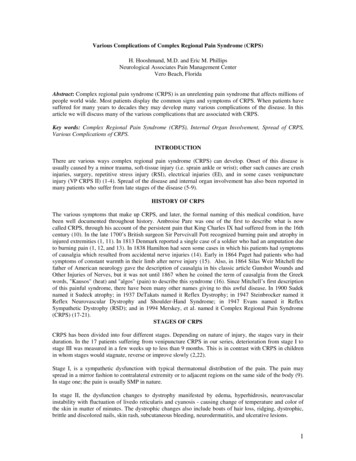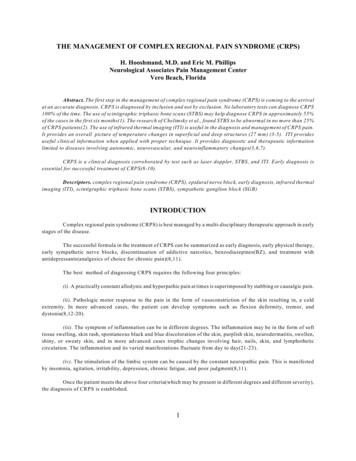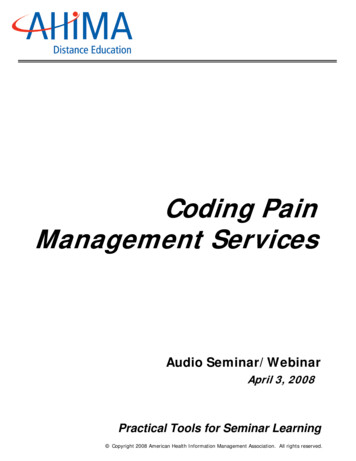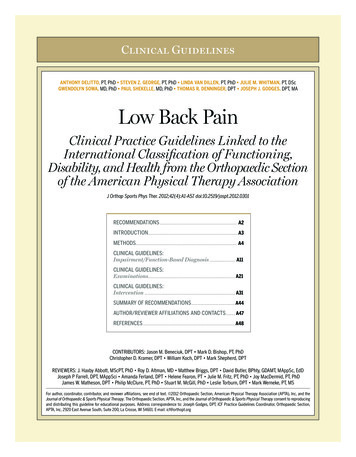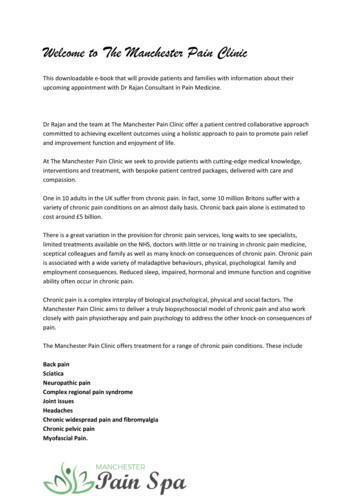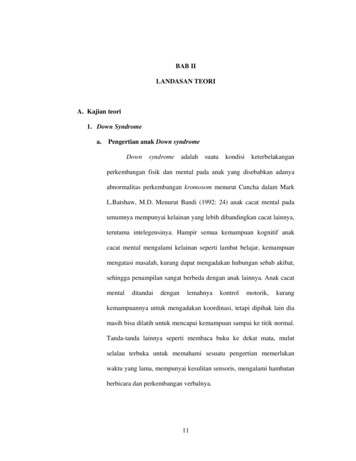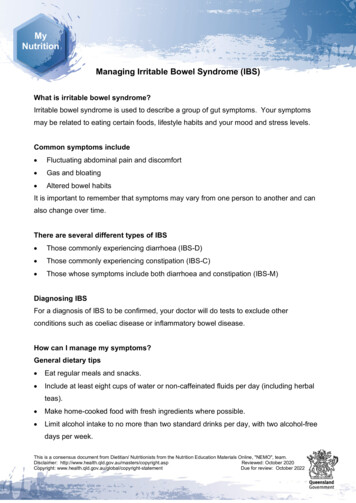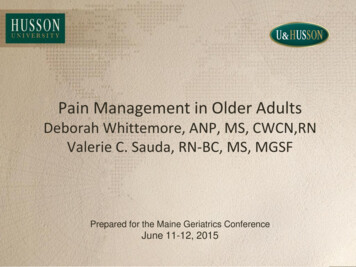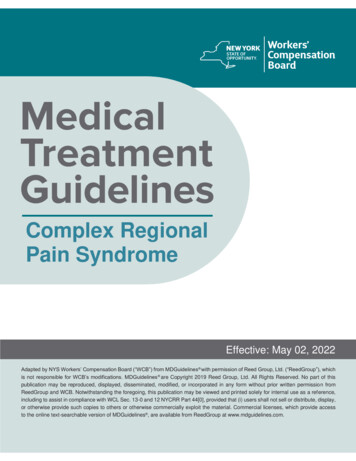
Transcription
Complex RegionalPain SyndromeEffective: May 02, 2022Adapted by NYS Workers’ Compensation Board (“WCB”) from MDGuidelines with permission of Reed Group, Ltd. (“ReedGroup”), whichis not responsible for WCB’s modifications. MDGuidelines are Copyright 2019 Reed Group, Ltd. All Rights Reserved. No part of thispublication may be reproduced, displayed, disseminated, modified, or incorporated in any form without prior written permission fromReedGroup and WCB. Notwithstanding the foregoing, this publication may be viewed and printed solely for internal use as a reference,including to assist in compliance with WCL Sec. 13-0 and 12 NYCRR Part 44[0], provided that (i) users shall not sell or distribute, display,or otherwise provide such copies to others or otherwise commercially exploit the material. Commercial licenses, which provide accessto the online text-searchable version of MDGuidelines , are available from ReedGroup at www.mdguidelines.com.
The NYS Workers’ Compensation Board would like to thank the members of the New York Workers’Compensation Board Medical Advisory Committee (MAC). The MAC served as the Board’s advisorybody to adapt the American College of Occupational and Environmental Medicine (ACOEM) PracticeGuidelines to a New York version of the Medical Treatment Guidelines (MTG). In this capacity, theMAC provided valuable input and made recommendations to help guide the final version of theseGuidelines. With full consensus reached on many topics, and a careful review of any dissentingopinions on others, the Board established the final product.New York State Workers’ Compensation Board Medical Advisory CommitteeJoseph Canovas, Esq.Special CounselNew York State AFL-CIOKenneth B. Chapman, MDDirector Pain Medicine, SIUH Northwell Health SystemsAssistant Clinical Professor, NYU Langone Medical CenterAdjunct Assistant Professor, Hofstra Medical SchoolRobert Goldberg, DOAttending Physician, Department of Rehabilitation, Beth Israel Hospital and Medical Center of NYCProfessor of Physical Medicine and Rehabilitation and Health PolicyClinical Associate Professor of Rehabilitation Medicine, New York Medical CollegeClinical Professor of Rehabilitation Medicine, Philadelphia College of Osteopathic MedicineMember Council on Medical Education of the American Medical AssociationHemant Kalia MD, MPH FIPPProgram Director, Interventional Spine & Pain Fellowship. Rochester Regional Health System,Rochester, NYClinical Assistant Professor, Physical Medicine & Rehabilitation, University of Rochester, NYClinical Assistant Professor: Department of Internal Medicine, Physical Medicine & Rehabilitation andPain Management. Lake Erie College of Osteopathic MedicineBoard of Directors, Monroe County Medical SocietyEditor-in-Chief, Advances in Clinical Medical Research & Healthcare DeliveryFrank Kerbein, SPHRDirector, Center for Human ResourcesThe Business Council of New York State, Inc.Winston C. Kwa, MD MPHMedical Director, Mount Sinai Selikoff Centers for Occupational Health-Mid-Hudson ValleyAssociate Professor, Mount Sinai School of MedicineJoseph Pachman, MD, PhD, MBA, MPHLicensed Psychologist and PhysicianBoard Certified in Occupational MedicineFellow in ACOEMVice President and National Medical Director, Liberty MutualJames A. Tacci, MD, JD, MPH (FACOEM, FACPM)NYS Workers’ Compensation BoardNYS WCB MTG – Complex Regional Pain Syndrome 2
Medical Director, and Executive Medical Policy DirectorEdward C. Tanner, MDChair, Department of Orthopaedics at Rochester General HospitalPast President, New York State Society of Orthopaedic Surgeons (NYSSOS)Member, American Academy of Orthopaedic Surgeons (AAOS)Member, American Association of Hip and Knee Surgeons (AAHKS)ACOEM Chronic Regional Pain Syndrome ContributorsKurt T. Hegmann, MD, MPH, FACOEM, FACPEvidence-based Practice Chronic Pain Panel Chair:Steven D. Feinberg, MD, MS, MPHEvidence-based Practice Chronic Pain Panel Members:Gerald M. Aronoff, MD, DABPM, DABPN, FAADEPJames Ausfahl, MDDaniel Bruns, PsyD, FAPABeth D. Darnall, PhDRachel Feinberg, PT, DPTJill S. Galper, PT, MEdLee Glass, MDRobert L. Goldberg, MD, FACOEMScott Haldeman, DC, MD, PhDJames E. Lessenger, MD, FACOEMSteven Mandel, MD, FACOEM, FAANTom G. Mayer, MDRussell L. Travis, MD, FACS, FAADEPPamela A. Warren, PhDThomas H. Winters, MD, FACOEMPanel members represent expertise in occupational medicine, physical medicine and rehabilitation,electrodiagnostic medicine, pain medicine, clinical psychology, psychiatry, neurology,electroencephalography, neurophysiology, neurosurgery, orthopedic surgery, physical therapy,exercise physiology, family medicine, legal medicine, medical toxicology, infectious disease, andchiropractic medicine. As required for quality guidelines (Institute of Medicine’s (IOM) Standards forDeveloping Trustworthy Clinical Practice Guidelines and Appraisal of Guidelines for Research andEvaluation [1]), a detailed application process captured conflicts of interest. The above panel has noneto declare relevant to this guideline.Methodology Committee Consultant:Jeffrey S. Harris, MD, MPH, MBA, FACOEMResearch Conducted By:Kurt T. Hegmann, MD, MPH, FACOEM, FACPMatthew S. Thiese, PhD, MSPHUlrike Ott, PhD, MSPHKristine Hegmann, MSPH, CICEmilee Eden, BSPranjal Abhinav MutheHarkomal KaurNYS WCB MTG – Complex Regional Pain Syndrome 3
Michael NorthrupJenna K. LindseyNatalie Victoria PrattSkyler David WalkerLisa Soffe, BSMatthew HoustonAlzina Koric, MPPJeremiah L. Dortch, BSJesse ReifsnyderDillon Joseph FixSpecialty Society and Society Representative ListingACOEM acknowledges the following organizations and their representatives who served as reviewersof the Chronic Pain Guideline. Their contributions are greatly appreciated. By listing the followingindividuals or organizations, it does not infer that these individuals or organizations support or endorsethe Chronic Pain Guidelines developed by ACOEM.American College of PhysiciansGeorge Comerci, Jr., MD, FACPAmerican Association of Neurological Surgeons and Congress of Neurological Surgeons –Joint Section on PainJulie G. Pilitsis, MD, PhDChristopher J. Winfree, MD, FACSAmerican Society of AnesthesiologistsMichael E. Harned, MDAssociation for Applied Psychophysiology and BiofeedbackGabriel E. Sella, MD, PhD, MPH, MSc, FAADP, FAAFP, FACPMOther Reviewers:Douglas W. Martin, MD, FACOEM, FAAFP, FIAIMENYS WCB MTG – Complex Regional Pain Syndrome 4
TABLE OF CONTENTSA.General Guideline Principles . 15A.16A.17A.18A.19A.20A.21A.22A.23A.24B.Medical Care . 9Rendering Of Medical Services . 9Positive Patient Response . 9Re-Evaluate Treatment . 9Education . 9Acuity . 10Initial Evaluation . 10Diagnostic Time Frames . 10Treatment Time Frames . 10Delayed Recovery . 10Active Interventions . 10Active Therapeutic Exercise Program . 11Diagnostic Imaging And Testing Procedures. 11Surgical Interventions . 11Pre-Authorization . 12Psychological/Psychiatric Evaluations. 12Personality/Psychological/Psychosocial Intervention . 13Functional Capacity Evaluation (FCE). 13Return To Work . 14Job Site Evaluation . 14Guideline Recommendations and Medical Evidence. 15Experimental/Investigational Treatment . 15Injured Workers As Patients . 15Scope Of Practice. 15Overview of Chronic Regional Pain Syndrome . 16B.1CRPS Diagnostic Criteria . 16C. Risk and Causation . 17D. Initial Assessment. 17D.1D.2D.3D.4E.Biopsychosocial Approach to CRPS . 24E.1E.2F.Red Flags . 18Symptoms and Signs. 20History . 21Physical Examination . 21Palliate or Rehabilitate . 24Psychological Issues . 25Diagnostic Testing . 26F.1F.2Psychological Evaluation for CRPS Patients . 27Laboratory Tests for Peripheral Neuropathic Pain . 27NYS WCB MTG – Complex Regional Pain Syndrome 5
F.3Antibodies for Diagnosing Chronic Pain with Suspicion of Rheumatological Disorder . 27F.4Antibodies to Confirm Specific Rheumatological Disorders. 28F.5Electrodiagnostic Studies (“EDS”, e.g. Nerve Condiction Velocities and NeedleElectromyelography) . 28F.6Autonomic Nervous System and Respiration (ANSAR) Testing for Diagnosing CRPS 28F.7Bone Scanning for Diagnosing CRPS (Triple-Phase) . 28F.8X-rays for Diagnosing CRPS . 29F.9Non-specific Inflammatory Markers for Screening for Inflammatory Disorders . 29F.10 Cytokine Tests for Diagnosing CRPS . 29F.11 Surface EMG for Diagnosing CRPS . 29F.12 Functional MRIs for Diagnosing CRPS . 29F.13 Local Anesthetic Injections for Diagnosing CRPS . 30F.14 QSART for Diagnosing CRPS . 30F.15 SPECT/PET for Diagnosing CRPS . 30F.16 Thermography for Diagnosing CRPS. 30G. Management of CRPS . 31G.1G.2G.3Initial Care . 31Activities and Activity Alteration . 32Work Activities . 33H. General Principles of Treatment . 35H.1I.Specific Treatment Interventions . 36Treatment of CRPS . 37I.1 Activity Modification and Exercise . 37J.Medications for the Treatment of CRPS . .15J.16J.17J.18Oral NSAIDs . 40Acetaminophen for CRPS. 40Intravenous NSAIDs for CRPS . 41Norepinephrine Reuptake Inhibitor Anti-depressants for CRPS . 41Duloxetine for CRPS . 41Selective Serotonin Reuptake Inhibitors (SSRIs), Bupropion, or Trazodone for CRPS42Antipsychotics for CRPS or CRPS-Related Neuropathic Pain . 42Anti-Convulsant Agents for CRPS . 42Gabapentin / Pregabalin (Short Term) for CRPS . 42Bisphosphonates for CRPS . 43Calcitonin for CRPS. 43Clonidine for CRPS . 43Oral Glucocorticosteroids for CRPS. 44Intrathecal Glucocorticosteroids for CRPS . 44Ketamine Infusion for CRPS . 45Ketanserin for CRPS . 45Magnesium Sulfate for CRPS . 45NMDA Receptor/Antagonists for CRPS . 45NYS WCB MTG – Complex Regional Pain Syndrome 6
J.19 Muscle Relaxants for CRPS . 45J.20 Thalidomide and Lenalidomide for CRPS . 45J.21 Capsicum Creams for CRPS . 45J.22 DMSO for CRPS . 45J.23 N-Acetylcysteine (NAC) for CRPS . 46J.24 EMLA Cream for CRPS . 46J.25 Tumor Necrosis Factor-alpha Blockers for CRPS . 46J.26 Intravenous Immunoglobulin (IVIG) for CRPS . 46J.27 Vitamin C for Prevention of CRPS in Patients with Distal Radius, Wrist, Hand, Ankle andFoot Fractures. 47J.28 Mannitol for Treatment of CRPS . 47K.Allied Health Interventions. .15K.16K.17L.Hyperbaric Oxygen for CRPS . 47Magnets and Magnetic Stimulation for CRPS . 47Occlusal Splint for CRPS . 47Taping and Kinesiotaping for CRPS . 47Acupuncture for CRPS . 47Diathermy for CRPS . 47Open Sympathectomy and External Radiation for Sympathetic Blockade for CRPS. 48Open Sympathectomy, including by external radiation for sympathetic blockade . 48Infrared Therapy for CRPS . 48Low-level Laser Therapy for CRPS . 48Manipulation for CRPS . 48Massage for CRPS . 48Myofascial Release for CRPS. 48Reflexology for CRPS . 48Hot and Cold Therapies . 48Electrical Therapies . 49Injection Therapies . 49Surgical Considerations . 53L.1L.2M.Spinal Cord Stimulators for Short- to Intermediate-term Relief of CRPS . 53Amputation for CRPS . 54Rehabilitation . 54M.1 Work Conditioning, Work Hardening, Early Intervention Programs for CRPS . 56M.2 Tertiary Pain Programs: Interdisciplinary Pain Rehabilitation Programs, MultidisciplinaryRehabilitation Programs, Chronic Pain Management Programs, and Functional RestorationPrograms . 57N.Behavioral Interventions . 59N.1N.2N.3N.4Psychological Evaluation for CRPS Patients . 61Cognitive Behavioral Therapy for Patients with CRPS . 62Fear Avoidance Belief Training . 63Biofeedback. 64NYS WCB MTG – Complex Regional Pain Syndrome 7
Appendix 1:Basic Definitions of Terms Often Used in the Context of CRPS . 65Appendix 2:Areas of Inquiry for Initial CRPS History . 69Appendix 3:Components of Interval Pain History to be Considered by Provider . 73Appendix 4:CRPS Management Algorithm . 76Appendix 5:Evidence Tables . 77Appendix 6: Systematic and Non-Systematic Reviews, Low Quality RCTs and Non-RandomizedStudies . 263References . 293NYS WCB MTG – Complex Regional Pain Syndrome 8
Guiding PrinciplesA.General Guideline PrinciplesThe principles summarized in this section are key to the intended application of the New YorkState Medical Treatment Guidelines (MTG) and are applicable to all Workers’ CompensationMedical Treatment Guidelines.A.1Medical CareMedical care and treatment required as a result of a work-related injury should befocused on restoring functional ability required to meet the patient’s daily and workactivities with a focus on a return to work, while striving to restore the patient’s health toits pre-injury status in so far as is feasible.A.2Rendering Of Medical ServicesAny medical provider rendering services to a workers’ compensation patient mustutilize the Treatment Guidelines as provided for with respect to all work-related injuriesand/or illnesses.A.3Positive Patient ResponsePositive results are defined primarily as functional gains which can be objectivelymeasured. Objective functional gains include, but are not limited to, positionaltolerances, range of motion, strength, endurance, activities of daily living (ADL),cognition, psychological behavior, and efficiency/velocity measures which can bequantified. Subjective reports of pain and function may be considered and givenrelative weight when the pain has anatomic and physiologic correlation in proportion tothe injury.A.4Re-Evaluate TreatmentIf a given treatment or modality is not producing positive results within a well-definedtimeframe, the provider should either modify or discontinue the treatment regime. Theprovider should evaluate the efficacy of the treatment or modality 2 to 3 weeks after theinitial visit and 3 to 4 weeks thereafter. These timeframes may be slightly longer in thecontext of conditions that are inherently mental health issues, and shorter for othernon-musculoskeletal medical conditions (e.g. pulmonary, dermatologic etc.).Recognition that treatment failure is at times attributable to an incorrect diagnosis afailure to respond should prompt the clinician to reconsider the diagnosis in the eventof an unexpected poor response to an otherwise rational intervention.A.5EducationEducation of the patient and family, as well as the employer, insurer, policy makers andthe community should be a primary emphasis in the treatment of work-related injury orillness. Practitioners should develop and implement effective educational strategiesand skills. An education-based paradigm should always start with communicationproviding reassuring information to the patient. No treatment plan is complete withoutaddressing issues of individual and/or group patient education as a means offacilitating self-management of symptoms and prevention of future injury.NYS WCB MTG – Complex Regional Pain Syndrome 9
TimeframesA.6AcuityAcute, Subacute and Chronic are generally defined as timeframes for disease stages: Acute – Less than one month Subacute - One to three month Chronic - greater than three monthsA.7Initial EvaluationInitial evaluation refers to the acute timeframe following an injury and is not used todefine when a given physician first evaluates an injured worker (initial encounter) in anoffice or clinical setting.A.8Diagnostic Time FramesDiagnostic time frames for conducting diagnostic testing commence on the date ofinjury. Clinical judgment may substantiate the need to accelerate or decelerate the timeframes discussed in this document.A.9Treatment Time FramesTreatment time frames for specific interventions commence once treatments havebeen initiated, not on the date of injury. It is recognized that treatment duration may beimpacted by disease process and severity, patient compliance, as well as availability ofservices. Clinical judgment may substantiate the need to accelerate or decelerate thetime frames discussed in this document.A.10 Delayed RecoveryFor those patients who fail to make expected progress 6-12 weeks after an injury andwhose subjective symptoms do not correlate with objective signs and tests,reexamination in order to confirm the accuracy of the diagnosis and re-evaluation ofthe treatment program should be performed. When addressing a clinical issue that isnot inherently a mental health issue, assessment for potential barriers to recovery(yellow flags/psychological issues) should be ongoing throughout the care of thepatient. At 6-12 weeks, alternate treatment programs, including formal psychologicalor psychosocial evaluation should be considered. Clinicians must be vigilant for anypre-existing mental health issues or subsequent, consequential mental health issuesthat may be impacting recovery. For issues that are clearly and inherently mentalhealth issues from the outset (i.e. when it is evident that there is an underlying, workrelated, mental health disorder as part of the claim at issue), referral to a mental healthprovider can and should occur much sooner. Referrals to mental health providers forthe evaluation and management of delayed recovery do not indicate or require theestablishment of a psychiatric or psychological condition. The evaluation andmanagement of delayed recovery does not require the establishment of a psychiatric orpsychological claim.Treatment ApproachesA.11 Active InterventionsNYS WCB MTG – Complex Regional Pain Syndrome 10
Active interventions emphasizing patient responsibility, such as therapeutic exerciseand/or functional treatment, are generally emphasized over passive modalities,especially as treatment progresses. Generally, passive and palliative interventions areviewed as a means to facilitate progress in an active rehabilitation program withconcomitant attainment of objective functional gains.A.12 Active Therapeutic Exercise ProgramActive therapeutic exercise program goals should incorporate patient strength,endurance, flexibility, range of motion, sensory integration, coordination, cognition andbehavior (when at issue) and education as clinically indicated. This includes functionalapplication in vocational or community settings.A.13 Diagnostic Imaging And Testing ProceduresClinical information obtained by history taking and physical examination should be thebasis for selection of imaging procedures and interpretation of results. All diagnosticprocedures have characteristic specificities and sensitivities for various diagnoses.Usually, selection of one procedure over others depends upon various factors, whichmay include: relative diagnostic value; risk/benefit profile of the procedure; availabilityof technology; a patient’s tolerance; and/or the treating practitioner’s familiarity with theprocedure.When a diagnostic procedure, in conjunction with clinical information, providessufficient information to establish an accurate diagnosis, a second diagnosticprocedure is not required. However, a subsequent diagnostic procedure including arepeat of the original (same) procedure can be performed, when the specialtyphysician (e.g. physiatrist, sports medicine physician or other appropriate specialist)radiologist or surgeon documents that the initial study was of inadequate quality tomake a diagnosis. Therefore, in such circumstances, a repeat or complementarydiagnostic procedure is permissible under the MTG.It is recognized that repeat imaging studies and other tests may be warranted by theclinical course and/or to follow the progress of treatment in some cases. It may be ofvalue to repeat diagnostic procedures (e.g., imaging studies) during the course of careto reassess or stage the pathology when there is progression of symptoms or findings,prior to surgical interventions and/or therapeutic injections when clinically indicated,and post-operatively to follow the healing process. Regarding serial imaging, (includingx-rays, but particularly CT scans), it must be recognized that repeat procedures resultin an increase in cumulative radiation dose and associated risks.A given diagnostic imaging procedure may provide the same or distincti
Program Director, Interventional Spine & Pain Fellowship. Rochester Regional Health System, Rochester, NY Clinical Assistant Professor, Physical Medicine & Rehabilitation, University of Rochester, NY Clinical Assistant Professor: Department of Internal Medicine, Physical Medicine & Rehabilitation and Pain Management.
